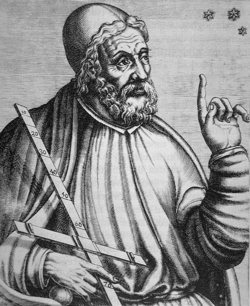 Our knowledge about Ptolemy is based exclusively on his works; nothing is known about his life.
Our knowledge about Ptolemy is based exclusively on his works; nothing is known about his life.Mathematician, astronomer and geographer;
worked c. 127 - 145 AD (Alexandria, Egypt)
 Our knowledge about Ptolemy is based exclusively on his works; nothing is known about his life.
Our knowledge about Ptolemy is based exclusively on his works; nothing is known about his life.
Ptolemy was an excellent geometrician, and his works on geometry are among his best. He was also a gifted mathematician, devising new geometrical theorems and proofs. Being primarily interested in astronomy, he studied the projection of points on the celestial sphere onto three perpendicular planes defined by the horizon, the meridian and the vertical, a system still used today.
By far the most important of his works is the Almagest. Its original title was He mathematike syntaxis ("The Mathematical Collection"). It was such an encyclopaedic summary of astronomical knowledge that it soon became known as Ho megas astonomos "The Great Astronomer"). Arab astronomers of the 9th century considered it Megiste ("Greatest"), added the Arabian definite article al and referred to it as al-Megiste ("The Greatest") or Almagest.
The Almagest describes in great detail the arrangement of the sun, the planets and all stars in a system where the Earth is at rest in the centre of the universe. It also contains a star catalogue of 1,022 stars, an effort not even surpassed by Kepler in the 15th century.
Ptolemy modified the mathematical model of deferents and epicycles (circles moving on circles) that existed at the time to describe the observed movement of the planets and improved its capability to predict their movement. His system, known as the Ptolemaic system, became the accepted view of the universe for 1,400 years. (During the 16th century the increased accuracy of star observations made it impossible to ignore the discrepancies between Ptolemy's system and actual star movement, and Galilei began to teach that the Earth revolves around the Sun.)
Other works of Ptolemy include
Ptolemy's geographical works were of lesser quality. They contained many errors: The equator was too far north, the circumference of the Earth was 30% too small (other scientists had already established much more correct values), Asia reached much further east than in reality, and the Indian Ocean was bounded in the south by another continent. Scientifically the most important contribution was his application of mathematics to the mapping of positions on Earth according to latitude and longitude.
Ptolemy's reputation as an excellent geometer and astronomer made his geographical works more credible than they should have been, and their influence was far-reaching. Columbus used them in the 15th century as an argument that it would not be difficult to reach India going west. The belief in a great southern continent was not abandoned until 1775, when James Cook returned from his voyage to the Southern Hemisphere.